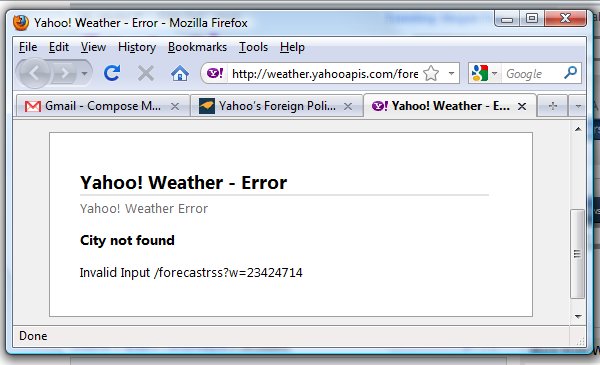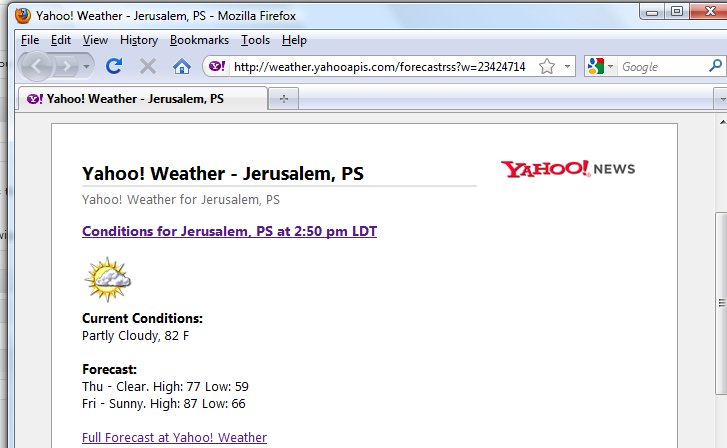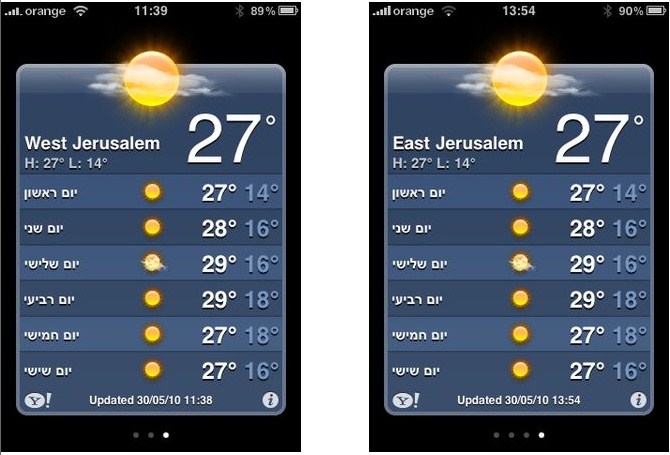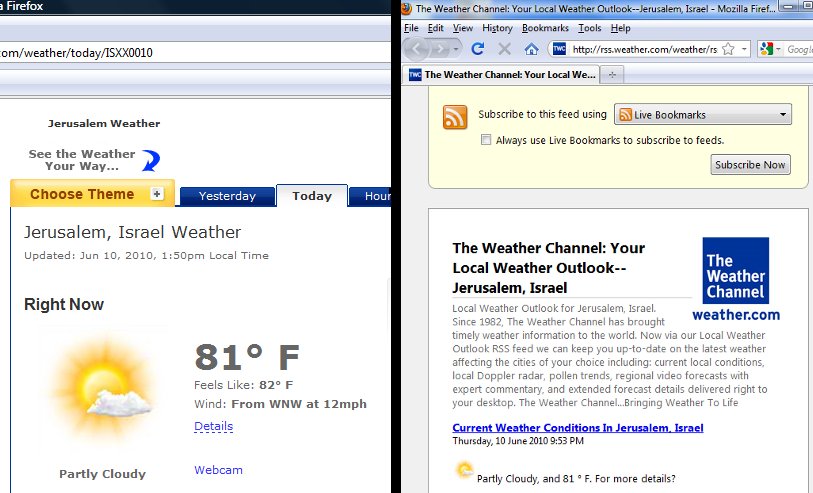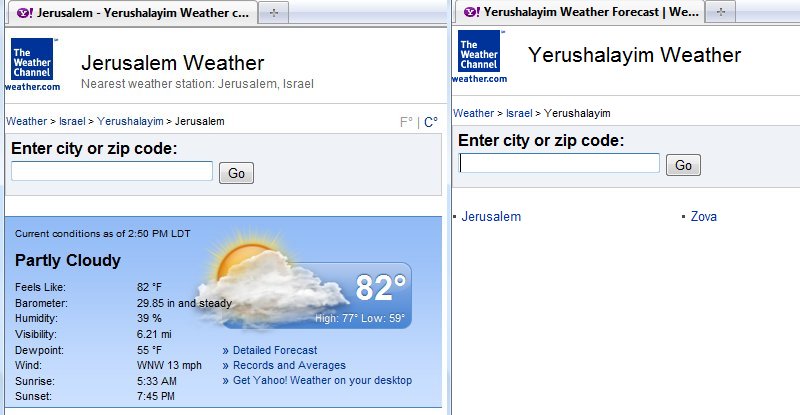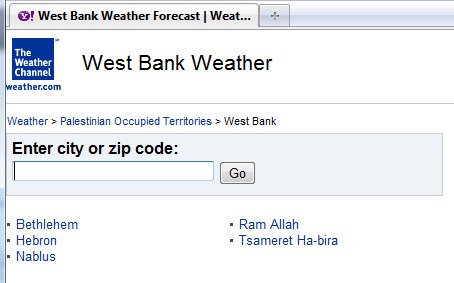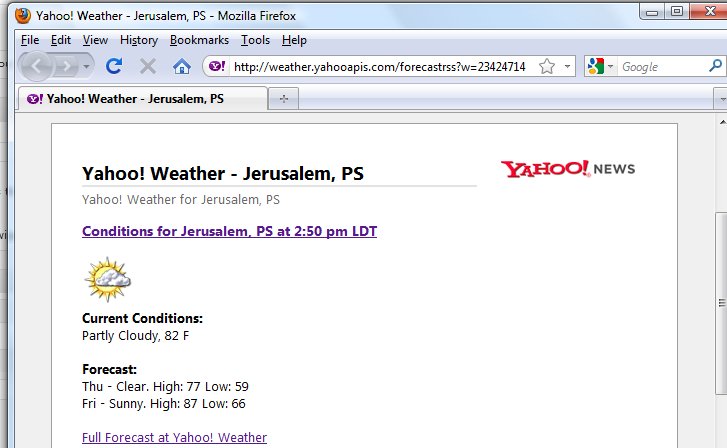UPDATE (16 June 2010):
Yahoo! have responded to wide spread criticism over their unilateral division of Jerusalem by reuniting the city. The imaginary Jerusalem in the West Bank has been deleted from the Yahoo servers. Now if you visit the location (via our link below) you get this error:
Previously you got this:
Well done to Honest Reporting and Mere Rhetoric who we have worked with on this problem. It’s always great to get a good outcome. The Honest Reporting report on this success is here.
THE ORIGINAL REPORT:
Honest Reporting have published a Communique explaining how Yahoo divides Jerusalem. The Honest Reporting article includes my conclusions on the problem. In this article I outline the facts leading to those conclusions.
Yahoo seems to have created its own foreign policy, in which Jerusalem is a divided city. The practical result is many people with iphones have noticed the default weather application has stopped providing data for Jerusalem. If the Jerusalem setting is cleared, when trying to put it back one is confronted with not one but two Jerusalem. One in Israel and one in the West Bank, a location in the Palestinian Occupied Territories. While the data is supplied by the weather channel, the artificial division of Jerusalem, artificial in both technology and political terms, is entirely due to a decision made at Yahoo.
Here’s how the weather works:
The weather channel provides weather for various points on the globe. The current weather is calculated using data from weather stations at known fix locations and from other sources. Each has a location code used by the weather channel. The code for Jerusalem is ISXX0010. It has only one code. You can access the weather for Jerusalem directly from the weather channel’s website at http://www.weather.com/weather/today/ISXX0010 or from their RSS feed at: http://rss.weather.com/weather/rss/local/ISXX0010
Yahoo! uses the data from the weather channel for their own website and weather feed. The Yahoo! use their own location codes which map places they have entered in their location database to the nearest location for which the weather channel gives data. In the Yahoo system places have countries, states / regions, and finally a specific locality. Tied to this locality is the actual location of a weather channel location (one identifiably by a weather channel location code).
The Yahoo! weather feed this provides data for the country: United States, State: District of Columbia and location: Washington. This can we seen on their site at http://weather.yahoo.com/united-states/district-of-columbia/washington-2514815/. Below the name it gives the location of the Weather Channel location it is using for this yahoo location. In this case it says “Nearest weather station: Washington, United States”. Finally, note that you can click “District of Columbia” and it will zoom out and show you all the locations it lists in DC. There is actually only one, the one called Washington which we just came from.
In a similar way we can visit Country: Israel, state / region: yerushalayim, location: Jerusalem. You can see this here: http://weather.yahoo.com/israel/yerushalayim/jerusalem-1968222/. Like before we see the nearest weather station: “Nearest weather station: Jerusalem, Israel”. And like before we can zoom out, by clicking yerushalayim, and this time we see that the region has two locations: Jerusalem and Zova. You can click on either of these to zoom back in. If we click Zova we see that it lists it’s nearest weather station (from the Weather channel) as “Zova, Israel”.
Finally we get to Country: Palestinian Occupied Territories, Region: West Bank, Location: Jerusalem. This one can be seen online at: http://weather.yahoo.com/palestinian-occupied-territories/west-bank/jerusalem-23424714/. Strangely below the name it says “Nearest weather station: Jerusalem, Israel”. Yahoo! have deliberately split one location in the weather channel system into two. It is as mentioned an artificial split. They are simply repeating the same data under another name. They haven’t even done the job of adding this “new location” properly. If you zoom out by clicking on West Bank the choices to zoom back in include Bethlehem, Hebron, Nablus, Ram Allah and Tsameret Ha-bira. Jerusalem in the West Bank is not listed – despite the fact we just came from there. Another sign it has been artificially created.
In addition to seeing weather on the website, yahoo provides something called an API for their weather program. An API or Application programming interface, is a way of providing data to other computer programs. It’s likely the weather app on Apple iPhones use this API. The Yahoo! Weather API provides an RSS feed of the weather in a similar way to the Weather Channel’s RSS. It can be accessed through a web browser using the address http://weather.yahooapis.com/forecastrss?w=<CODE>. Code in this case is the number we previously saw when browsing the weather through the yahoo website. Washington was 2514815, Jerusalem in Israel was 1968222 and Jerusalem in the West Bank was 23424714. We can view Jerusalem in the West Bank by going to http://weather.yahooapis.com/forecastrss?w=23424714 (the really long ID number given indicated it was just created). You’ll note that you can click “Conditions for Jerusalem, PS at 4:50 pm LDT” to go back to the website. If you click it takes you to the page for Jerusalem – in Israel. That is, back to http://weather.yahoo.com/israel/yerushalayim/jerusalem-1968222/.
From all this we see the underlying database structure Yahoo have created. They have a table of countries, this links to a table of regions, the regions table links to a table of localities. In the localities table we have fields for the locality ID number, the locality name, and a Weather channel ID of the nearest weather station.The designers of the database logically thought a region could only belong to one country, and a locality could only belong to one region. Provided the database uses the yahoo locality number, or some other unique ID as the primary key in the localities table this should not stop yahoo having the same weather channel location show up in multiple yahoo localities. It’s dishonest, but technically possible. It looks like the effort to add and manipulate data was done by someone not as familiar with the system as the original designers. They didn’t update the other tables to link to their new locality items. This is why Jerusalem in the West Bank is not listed. The model of the system is supported by the mess that has been made of Haifa. It had the correct spelling via the weather channel, but two different incorrect spellings (Hefa and H’efa [with an apostrophe]) in the yahoo locality and region tables.
Yahoo have clearly decided to artificially divide Jerusalem. They are contorting their systems in all sorts of strange ways to do it. The question we must ask is what right does Yahoo have to use the data from an Israeli weather station in order to divide Jerusalem? This is deliberate dishonesty. According to their own data, the West Bank does not contain a place called Jerusalem. The weather station is in Israel. This is nothing more than a manipulation of data to advance political propaganda. This is worse than the case of Google Maps. In the Google case the data was provided by a political activist in the user community and Google failed to check the data before people under the direct control of the company uploaded it to the core later. Google eventually accepted that political advocacy did not belong in the core layer and because people under their direction ultimately did the uploading their initial argument of “user content” was invalid. In this case there are no users involved. This is a deliberate attempt by a large multinational internet corporation to play politics in the middle east. The Mere Rhetoric blog documents other Yahoo forays into politicization of the weather application. Yahoo should not be surprised if their political activism comes at a cost. Not just from supporters of Israel but from consumers generally. We as consumers never gave internet companies the right to formulate foreign policy or (as Facebook recently found) privacy policies. We elect governments to do these things. Yahoo, a corporate entity, should learn its place and stick to it.
Dr Andre Oboler is the Director of the Community Internet Engagement Project at the Zionist Federation of Australia. He holds a PhD in Computer Science from Lancaster University in the UK, and In 2008 was a post-doctoral fellow focused on Online Public Diplomacy in the political science department at Bar-Ilan University in Israel.
Permission is granted to reproduce this article in full or in part provided authorship is acknowledged and a link is provided back to the original at the CIE website.

